“The heavens proclaim the glory of God,” writes the psalmist. As an astronomer at the Vatican Observatory, I get to enjoy those proclamations on a daily basis. But you don’t have to be a professional astronomer to appreciate the beauty that our instruments have shown us.
There are hundreds of websites online where startling astronomical images can be found. Perhaps the most accessible is the Astronomy Picture of the Day website and app, which, as its name implies, posts a different astronomy image every day, along with a short description to let you know what you are looking at. Lots of those images come from spacecraft, but just as many come from Earth-based observatories. Indeed, nowadays some of the best astronomical postcards come from the telescopes of advanced amateurs.
The images can speak for themselves. But to have an idea of the message behind the images makes them even richer. Here are a handful of some of my favorite recent astronomical images, both from space and from closer to home.
As a scientist, I know that what I am looking at in the image that heads this article is a wonderful example of an interstellar cloud in the Trifid Nebula (M20) compressed by the shock of a nearby supernova. At the tip of a spire of cloud in the upper left corner, gas is being squeezed into a tighter cloud that will eventually form a disk. Out of that disk a system of stars and planets will be born. (The longer corkscrew streak to its left is a gas jet emitted from the cloud.)
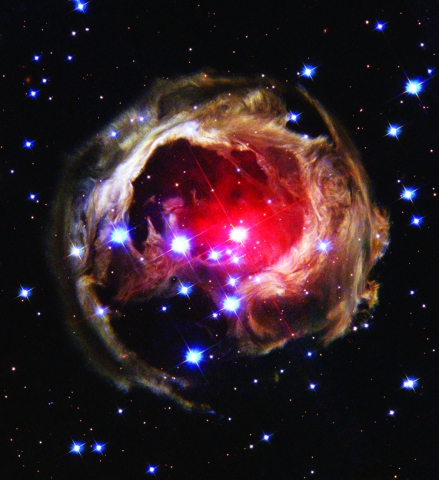
But I’m also a human being, and indeed a fan of fantasy stories. So there’s a part of me that can’t help but anthropomorphize images like these, looking to put “faces” in the clouds—in this case, the outline of a unicorn. This sort of game has a long and honored history; our constellations, and indeed many of the nebulae shown here, have “popular” names (like the “Trifid Nebula”) that help us tell them apart, as they remind us what they look like. It’s fun to enjoy the two together, to think that I’m seeing a solar system being born in the tip of a unicorn’s ear.
One final thrill: On a good night, my little backyard three-inch telescope can make out the Trifid Nebula quite nicely. On a really dark summer night in June or July, I can spot it with my naked eye as a tiny patch of light, just off the Milky Way in the constellation of Sagittarius, the Archer. Obviously I won’t see the detail shown here; but the fact is, wonderful sights in the sky are visible to anyone who knows where to look.
That’s something I really appreciate about astronomy. It is open to anyone. You don’t have to be an expert to appreciate the wonders of the night sky. Of course, once you get a taste of the thrill it can bring, you will be tempted into learning more, and becoming more of an expert—at your own pace, in your own way. It’s an example of how the Creator speaks to us where we are, but then invites us to come closer, and know deeper.
Speaking of unicorns, there actually is a constellation called Monoceros, the Unicorn. It sits just to the east of the more famous constellation of Orion, the Hunter. A star in Monoceros V838 is a “supergiant” that exploded in 2002, briefly becoming the brightest star in the Milky Way. (Intrinsically brightest, that is, not the brightest in our own skies; it was never quite visible to the naked eye here on Earth, because it is so far away.)
When the Hubble Space Telescope took this image, the star had already faded, but the light from its explosion could still be seen echoing off the gas and dust surrounding the star. As we look at different times, we see different rings of gas illuminated by this light. On the Internet you can find many Hubble images of V838, each different in a subtle way, as we watch the light cross the field of gas. The fact that there is so much gas and dust nearby tells us that this isn’t the first time this star has had a large “burp.” Eventually this star will die completely; its gas and dust will eventually find its way into a larger cloud, like the one in the previous picture, out of which new stars will be formed.
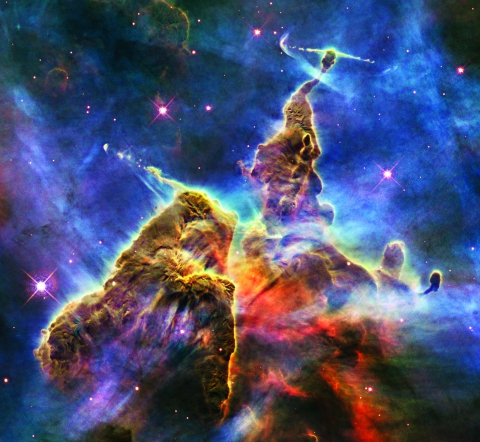
This image touches me on many levels—starting with the fact that it reveals “many levels” in the cloud of gas and dust. It reminds me, in fact, of the large brass sculpture, Sfero con Sfero, (“Sphere within a Sphere”) by Arnaldo Pomodoro, situated at the Vatican in the Garden of the Pine Cone, well known to visitors as a part of the Vatican Museum. The Italian sculptor deliberately designed his work to lead the viewer into contemplating deeper and deeper into the heart of things, reminding us of both the complexity and fragility of our universe.
Here in space, we have a divine artist with a similar message!
And speaking of exploding stars, the brightest such explosion ever recorded occurred in the Carina Nebula, located in the southern hemisphere constellation of Carina. Between 1820 and 1843, a star in this nebula, Eta Carinae, underwent its “great eruption.” For a few years it was actually the second brightest star visible in our skies, before fading back to relative obscurity. Theorists are still arguing what caused the eruption; it wasn’t quite a supernova, but it was certainly stronger than anything that ordinary stellar evolution theory would predict.
The Carina Nebula itself, like M20, is visible to the naked eye—at least if you’re in the southern hemisphere. From Australia it is utterly charming in a small telescope. But the nebula is a part of a much larger star formation region, including this mountain of gas and dust imaged by the Hubble in 2010. As with the Trifid Nebula, the gas and dust seen here come from exploding stars. Then a nearby supernova compresses that gas and dust into pillars and columns. At the end of each column the material is compressed into a region from which new stars are formed. In a few million years this cloud will be a cluster of young stars.
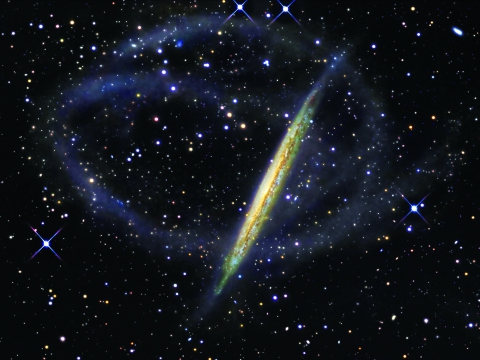
What strikes me in images of nebulae like these is that, while the frame is dominated by the mass of the nebula, all the really important “action”—the collapse of the gas into stars and disks that eventually will form planets—is occurring at the edges, in the thin wispy bits that you have to look at carefully in order to see. The wisps wouldn’t exist without the gas cloud. But the gas cloud would be sterile and inert without those wisps.
Another thing also delights me about it, however. I can understand the physics that describes how these clouds balance the pressure of their gas with the gravity of their mass on a knife-edge, so that star formation can be triggered with just the nudge from a nearby supernova. That’s all quite rational, and it’s possible to write down formulae that describe how all this works. What’s unexpected, however, is how beautiful it all looks when we actually see it occurring. Mathematicians like to call this blend of reason and beauty “elegance.” It seems to be a hallmark of the Creator.
And sometimes, I swear, God’s just having fun! This wild curlicue of light is a ghostly stream of stars surrounding the spiral galaxy NGC 5907. This object is not something in our own Milky Way Galaxy of stars, but it is itself an entirely separate collection of many billions of stars located some 50 million light-years away from our home galaxy. The stream of stars seen here was ripped from a smaller dwarf galaxy that NGC 5907 encountered some 4 billion years ago.
Such “collisions” of galaxies are apparently quite common in the history of the universe. As it happens, the stars themselves in the colliding galaxies never actually touch. What happens instead is that once two galaxies come close enough, the gravity of the one can pull noticeably on the stars of the other, so that the larger galaxy will incorporate the smaller one. Eventually they merge together to make a newer, larger, and more complex structure of stars, gas, and dust.
I am a planetary astronomer, but I have deliberately limited myself to only this one planetary image. There are so many wonderful spacecraft images that it is hard to choose from them; but worse, I can’t see an image of a planet or asteroid without thinking of all the science behind it, stuff that fascinates me because I know the backstory, but which often is of interest only to the specialist.
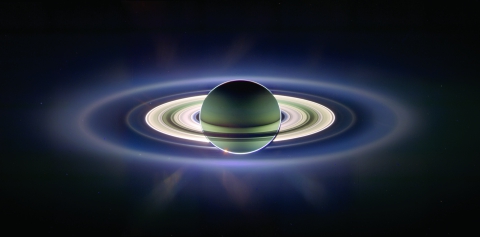
This image of Saturn, the planet with a “halo,” clearly has both things going for it: incredible beauty and fascinating science behind it. Taken by the NASA/ESA Cassini spacecraft that has been orbiting Saturn since 2004, this image from 2006 has a unique view of the ringed planet. The spacecraft was on the side of Saturn opposite the sun, and so instead of seeing sunlight reflected off Saturn’s clouds and the large chunks of ice in its rings, we’re seeing that light passing through the faint dust that fills those rings between the chunks and surrounds the planet. Just like the way dust in a room shows up in a beam of sunlight pouring through a window, this “forward-scattered” light shows us the parts of the rings that are particularly dusty, including some remarkable individual streams of dust that may be spalling off small moonlets orbiting Saturn outside the rings.
The big outer dusty ring visible here is especially interesting. It sits at the orbit of Saturn’s moon Enceladus, and it appears to be made up of water vapor pouring out of a series of active volcanoes on the southern pole of that moon. It was long theorized that icy moons might be molten inside—my thesis at MIT in 1975 was on that very topic—but these volcanoes, and this ring, are the first proof that the idea was actually correct.
One other tiny dot of light in this image is the final capper. Inside the Enceladus ring is a thinner dusty ring; look just inside it, at about 10 o’clock, for a tiny dot of light. That’s us: That is planet Earth, as seen from Saturn.
Indeed, one of the reasons that we study other planets, other places in space, is for the chance to then look back upon ourselves. Who are we? How do we fit into this immense universe? It’s tempting to think that we must be insignificant, just a tiny dot easily lost in the billions of stars and galaxies. One might despair, how could God ever notice me?
But we can turn that same contemplation around, and rejoice in the immensity of a God who, even given the vastness of creation, nonetheless has the time and ability to turn his attention individually on each of us.
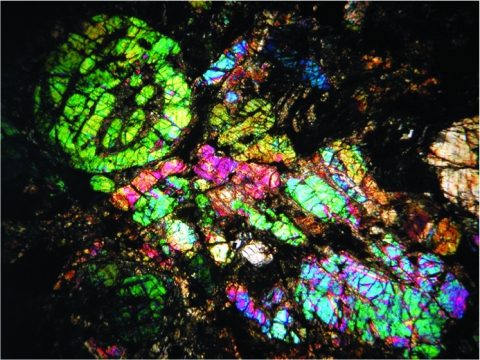
I am ending this series with one of my personal favorites: an image I took myself. For this picture I used a microscope, not a telescope. This is looking at a thin (1/100 of a millimeter thin) sliver of a meteorite.
Meteorites are rocks from space, usually from the asteroid belt, which hit the Earth on a regular basis. They provide us with free samples of the material that the rest of the planets are made from. This particular meteorite hit near the town of Knyahinya, Ukraine in 1866.
The light shining through this thin section was polarized in one direction, and then after it passed through the sample it was polarized in the opposite direction. Only certain colors of light have their polarization twisted by the rock just enough to pass both filters; the result is the marvelous collection of colors seen here.
Notice the round bit at the upper left. This is a “chondrule,” a small bead less than a millimeter across, a droplet of rock molten and frozen in zero gravity as the planets were being formed 4.5 billion years ago. The other colored bits are themselves probably pieces of other broken chondrules.
Once again, the human imagination can play wonderful tricks with this image. With the round bit next to the straight bits I see an infant in a manger. In fact, we used this image one year at the Vatican Observatory for our Christmas cards!
But even leaving such flights of fancy behind, an image like this enriches both my knowledge and my heart. As a scientist, I can tell the chemical composition of the rock (mostly iron and magnesium oxides) from the colors of the minerals, and from the cracks I can work out its history of collisions and shock. From the very fact that these samples are in our lab—for us to hold and touch and measure—I am reminded that the sky is not some barrier between us and “outer space,” but in fact the cosmos comes and touches us on a regular basis. And from the beauty of what I see here, I am reminded why I do this work: for that sense of joy and awe I find in creation, the autograph of the Creator.
This article appeared in the February 2014 issue of U.S. Catholic (Vol. 79, No. 2, pages 34-39).
Main Image: NASA Hubble Space Telescope Wide Field Planetary Camera 2, processed by J. Hester, Arizona State University


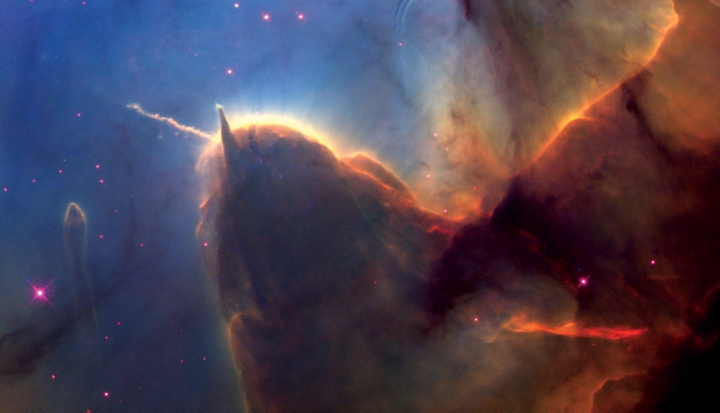











Add comment